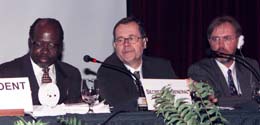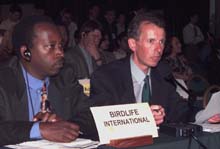 |
|
THE SEVENTH SESSION OF THE CONTRACTING PARTIES TO THE RAMSAR CONVENTION ON WETLANDS San José, Costa Rica 10-18 May 1999 |
 |
Final briefing |
DAILY COVERAGE |
||||||||||||||||||||||||||||||||||||
| The Seventh Meeting
of the Conference of the Contracting Parties (COP7) to the Convention on Wetlands (Ramsar,
Iran, 1971) took place from 10-18 May 1999 in San José, Costa Rica. COP7 focused on the
interrelations between human societies and wetland habitats, and the general theme of the
Conference was "People and Wetlands -The Vital Link." Approximately 750
participants attended COP7, including officials from 110 Contracting Parties (CPs) to the
Convention and 15 observer States, numerous national and international NGOs,
representatives of other convention secretariats and intergovernmental institutions, donor
agencies and wetland scientists. The programme included five technical sessions, on Ramsar
and Water, National Planning for Wetland Conservation and Wise Use, Involving People at
All Levels in the Conservation and Wise Use of Wetlands, Tools for Assessing and
Recognizing Wetland Values, and Frameworks for Regional and International Cooperation
Regarding Wetlan Delegates considered several substantive agenda items, including reviews of Convention implementation in each region, the Convention Work Plan and Ramsar budget for 2000-2002, and regional categorization of countries under the Convention, and considered and adopted 30 resolutions and 4 recommendations on policy, programme and budgetary issues to advance the work of the Convention into the next century. In addition, a Memorandum of Understanding (MOU) was signed between the Ramsar Secretariat and the World Heritage Center, two countries - Lebanon and Cuba -- announced their accession to the Convention, and numerous Contracting Parties (CPs) announced the designation of new Ramsar sites in their countries. |

|
Regarding admission of observers, delegates adopted the list of registered observers (COP7 DOC.3) with amendments to include Rwanda and UNEP. |
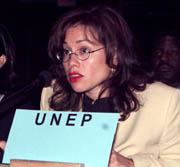 |
| Nayon Moses Bilijo (Ghana), Chair of the Technical Session, said the Convention is an act of international cooperation that sets CPs on new paths and presents new challenges. | |
TURKEY noted that amendments it had submitted to the drafting group on 'Guidelines For International Cooperation Under The Convention' (COP7 DOC.15.20) had not been incorporated. He reiterated his proposals to delete text relating to transboundary watercourses and management of shared river basins, as they are irrelevant and controversial in respect to the context and obligations of the Ramsar Convention. He emphasized that the resolution would not constitute a legally binding instrument for Turkey and requested that these reservations be reflected in the COP7 report. |
 |
| INDIA associated itself with the principles articulated by Turkey and stated that management of shared wetlands and river basins should be left to the CPs concerned. He emphasized that these are often sensitive issues and could get Ramsar into trouble if it attempts to address them, and suggested that if they must be tackled in a multinational forum, it should be the Commission on Sustainable Development. | |
WWF expressed concern that the draft resolution 'Issues Concerning The Boundary Definitions Of Ramsar Sites And Compensation Of Wetland Habitats' (COP7 DOC.15.26) contradicts the Convention. |
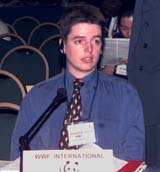 |
| Australia will prepare two case studies for COP8 consideration under the resolution COP7 DOC.15.26. The resolution seeks to establish that there can be situations other than that of "urgent national interest" allowed in the Convention in which Ramsar site boundaries may warrant further definition, for example where boundaries were erroneously defined at the time of listing. | |
'Compensation For Lost Wetland Habitats And Other Functions' (COP7 DOC.15.28) was considered on Tuesday, 18 May, and was adopted with minor amendments, including CANADA's proposed three-step mitigation sequence of avoidance, minimization and compensation. |
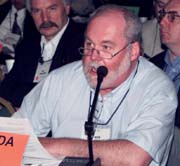 |
No other invitations were forthcoming, and delegates accepted Spain's invitation by acclamation. |
 |
| View of the meeting hall during the Closing Plenary | |
|
 |
Closing ceremony festivities included clowns and a traditional tico (Costa Rican) marching band. ¡Viva! |
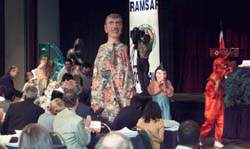 |
Post-conference interviews
Delmar Blasco, Secretary-General of the Ramsar Convention Bureau, and David E. Pritchard, International Treaty Advisor for BirdLife International, share their parting thoughts on COP7 with the ENB team in these exclusive interviews: |
|
|
|
|
The ENB team for Ramsar COP7, from right to left: Angela Churie, Nabiha Mageteli, Kira Schmidt and Chris Spence (behind the camera: Andrei Henry) |
 |
For the complete selection of previous days' briefings, images and RealAudio please go to the day's page:
© Earth Negotiations Bulletin, 1999. All rights reserved.
